Investigation of Stress Corrosion Cracking Resistance of Irradiated 12Cr Ferritic-Martensitic Stainless Steel in Supercritical Water Environment
Abstract
:1. Introduction
2. Material and Experimental Procedure
3. Load Calculation for Disc Specimens in the Loading Device
4. Autoclave Tests Results
5. Calculation of Specimen Deformation for Microcrack Opening
6. Additional Loading of Disk Specimens after SCC Tests
7. Discussion
7.1. Quantitative Analysis of Microcrack Sizes
7.2. Study of the Nature of Microcracks
7.3. Analysis of Possible SCC Mechanism
8. Conclusions
- 1.
- Special disk specimens from irradiated 12Cr F/M steel and loading devices for these specimens have been designed for autoclave SCC testing at constant load in an environment simulating the primary circuit coolant of the supercritical water-cooled reactors. The use of such specimens with loading devices allows one to test several specimens with different loading levels in the same autoclave in a supercritical environment.
- 2.
- Maximum relative stresses in disk specimens tested in the autoclave vary from 0.34σY to 0.64∙σY for materials irradiated at 390 °C and from 0.31∙σY to 0.69∙σY for materials irradiated at 550 °C. Such a wide stress range is necessary for the experimental determination of the threshold stress below which the SCC does not occur.
- The loads acting on the specimen in the loading device and providing the specified stresses were calculated by FEM.
- 3.
- Autoclave tests on SCC of disk specimens from 12Cr F/M steel irradiated to the damage dose of 12 dpa at temperatures of 390 °C and 550 °C were carried out at constant loads in the environment simulating the primary circuit coolant of SWCR for a time exceeding 500 h.
- 4.
- SEM examination of disk specimen surfaces after autoclave tests showed that corrosion microcracks could not be detected due to a sufficiently thick oxide film on the surface of the specimen. Therefore, a method allowing us to improve the detection of corrosion microcracks has been developed. The essence of the method is additional loading of the specimens after autoclave tests. The additional load should increase corrosion microcrack opening as well as oxide film cracking, while at the same time preventing the nucleation of microcracks by ductile or brittle mechanisms.
- 5.
- After additional loading, microcracks related to the SCC occurrence were detected by SEM on the surface of specimens irradiated at 390 °C and loaded in the autoclave at 605 N and 801 N. Microcracks related to the SCC occurrence were not observed either on the surface of the specimens irradiated at 390 °C and loaded in an autoclave at 423 N, or on the surface of the specimens irradiated at 550 °C. The SCC nature of these microcracks was confirmed by additional mechanical tests, SEM investigations, and EDS analysis of specimen zones located at different depths.
- 6.
- As a result of the autoclave tests, it was shown:
- 12Cr F/M steel irradiated at a temperature of 550 °C is not susceptible to SCC at stresses in the range 135÷304 MPa (0.31σY÷0.69σY) in the environment simulating the primary circuit coolant of SWCR. When the irradiation temperature is lowered to 390 °C, this steel is not susceptible to SCC at stresses below the threshold stress of 296 MPa (0.34∙σY). So, for 12Cr F/M steel irradiated in the temperature range (390÷550) °C, the threshold stress may be approximately assumed to be equal to 300 MPa.
- 7.
- It is shown that the formation of chromium carbides is not the main cause of SCC in irradiated 12Cr F/M steel. The main cause of SCC is the radiation hardening of the steel, which can potentially lead to localized deformation, the creep process, and an increase in the portion of creep strain due to GB sliding.
- 8.
- To clarify the SCC mechanisms, a TEM investigation and creep tests of irradiated 12Cr F/M steel should be provided in subsequent investigations.
Author Contributions
Funding
Institutional Review Board Statement
Informed Consent Statement
Data Availability Statement
Conflicts of Interest
References
- Kirillov, P.L. Supercritical parameters—The future of water-cooled reactors and nuclear power plants. At. Tekhnika Rub. 2001, 6, 3–8. [Google Scholar]
- Baranaev, Y.D.; Kirillov, P.L.; Poplavskiy, V.M.; Sharapov, V.N. Nuclear reactors with water at supercritical pressure. At. Energy 2004, 96, 374–380. [Google Scholar] [CrossRef]
- Dolgov, V.V. VVER Units with Supercritical Coolant Parameters. At. Energy 2002, 92, 277–280. [Google Scholar] [CrossRef]
- Was, G.; Ampornrat, P.; Gupta, G.; Teysseyre, S.; West, E.; Allen, T.; Sridharan, K.; Tan, L.; Chen, Y.; Ren, X.; et al. Corrosion and stress corrosion cracking in supercritical water. J. Nucl. Mater. 2007, 371, 176–201. [Google Scholar] [CrossRef]
- Huang, Y.; Zang, J.; Leung, L.K.-H. Super-Critical Water-Cooled Reactor (SCWR); Elsevier Inc.: Amsterdam, The Netherlands, 2021. [Google Scholar]
- Glebov, A.P.; Klushin, A.V. Reactor with a fast-resonance neutron spectrum, cooled by supercritical pressure water in a two-pass coolant motion scheme. At. Energy 2006, 100, 349–355. [Google Scholar] [CrossRef]
- Guzonas, D.; Novotny, R.; Pentilla, S.; Toivonen, A.; Zheng, W. Materials and Water Chemistry for Supercritical Water-Cooled Reactors; Woodhead Publishing Is an Imprint of Elsevier; Elsevier Ltd.: Amsterdam, The Netherlands, 2018. [Google Scholar]
- Guo, X.; Fan, Y.; Gao, W.; Tang, R.; Chen, K.; Shen, Z.; Zhang, L. Corrosion resistance of candidate cladding materials for supercritical water reactor. Ann. Nucl. Energy 2019, 127, 351–363. [Google Scholar] [CrossRef]
- Guzonas, D.; Novotny, R. Supercritical water-cooled reactor materials—Summary of research and open issues. Prog. Nucl. Energy Vol. 2014, 77, 361–372. [Google Scholar] [CrossRef]
- Hwang, S.S.; Lee, B.H.; Kim, J.G.; Jang, J. SCC and corrosion evaluations of the F/M steels for a supercritical water reactor. J. Nucl. Mater. 2008, 372, 177–181. [Google Scholar] [CrossRef]
- Sun, C.; Hui, R.; Qu, W.; Yick, S. Progress in corrosion resistant materials for supercritical water reactors. Corros. Sci. 2009, 51, 2508–2523. [Google Scholar] [CrossRef]
- Teysseyre, S. Corrosion Issues in Supercritical Water Reactor (SCWR) Systems. 2012. Available online: https://www.researchgate.net/publication/285986817_Corrosion_issues_in_supercritical_water_reactor_SCWR_systems (accessed on 13 March 2023).
- Muthukumar, N.; Lee, J.H.; Kimura, A. SCC behavior of austenitic and martensitic steels in supercritical pressurized water. J. Nucl. Mater. 2011, 417, 1221–1224. [Google Scholar] [CrossRef]
- Ampornrat, P.; Gupta, G.; Was, G.S. Tensile and stress corrosion cracking behavior of ferritic-martensitic steels in supercritical water. J. Nucl. Mater. 2009, 395, 30–36. [Google Scholar] [CrossRef]
- Teysseyre, S.; Was, G.S. Assessing SCC and IASCC of austenitic alloys for application to the SCWR concept. Structural Materials for Innovative Nuclear Systems (SMINS), Workshop Proceedings, Karlsruhe, Germany, 4–6 June 2007; Available online: https://www.oecd-nea.org/upload/docs/application/pdf/2019-12/6260-smins2008.pdf (accessed on 13 March 2023).
- Teysseyre, S.; Was, G.S. Stress Corrosion Cracking of Neutron Irradiated Steel in Supercritical Water. In 13th International Conference on Degradation of Materials in Nuclear Power Systems—Water Reactors; Allen, T.R., Busby, J., King, P.J., Eds.; Canadian Nuclear Society: Toronto, ON, Canada, 2007. [Google Scholar]
- Zinkle, S.J.; Was, G.S. Materials challenges in nuclear energy. Acta Mater. 2013, 61, 735–758. [Google Scholar] [CrossRef]
- Kofstad, P. High Temperature Corrosion; Elsevier: Amsterdam, The Netherlands, 1988. [Google Scholar]
- Margolin, B.; Sorokin, A.; Pirogova, N.; Toivonen, A.; Sefta, F.; Pokor, C. Analysis of mechanisms inducing corrosion cracking of irradiated austenitic steels and development of a model for prediction of crack initiation. Eng. Fail. Anal. 2020, 107, 104235. [Google Scholar] [CrossRef]
- Arioka, K.; Yamada, T.; Terachi, T. Influence of Carbide Precipitation and Rolling Direction on Intergranular Stress Corrosion Cracking of Austenitic Stainless Steels in Hydrogenated High-Temperature Water. Corrosion 2006, 62, 568–572. [Google Scholar] [CrossRef]
- Lozano-Perez, S.; Yamada, T.; Terachi, T. Multi-scale characterization of stress corrosion cracking of cold-worked stainless steels and the influence of Cr content. Acta Mater. 2009, 57, 5361–5381. [Google Scholar] [CrossRef]
- Nishioka, H.; Fukuya, K.; Fujii, K.; Torimaru, T. IASCC Initiation in Highly Irradiated Stainless Steels under Uniaxial Constant Load Conditions. J. Nucl. Sci. Technol. 2008, 45, 1072–1077. [Google Scholar] [CrossRef]
- Pogodin, V.P.; Bogoyavlenskiy, V.L.; Sentyurev, V.P. Intergranular Corrosion and Stress Corrosion Cracking of Stainless Steels in Water Environment; Atomizdat: Moscow, Russia, 1970. (In Russian) [Google Scholar]
- Logan, H.L. Stress Corrosion of Metals; John Wiley & Sons Inc.: Hoboken, NJ, USA, 1967. [Google Scholar]
- Was, G.S.; Farkas, D.; Robertson, I.M. Micromechanics of dislocation channeling in intergranular stress corrosion crack nucleation. J. Nucl. Mater. 2012, 16, 134–142. [Google Scholar] [CrossRef]
- Karlsen, W.; Diego, G.; Devrient, B. Localized deformation as a key precursor to initiation of intergranular stress corrosion cracking of austenitic stainless steels employed in nuclear power plants. J. Nucl. Mater. 2010, 406, 138–151. [Google Scholar] [CrossRef]
- Jiao, Z.; Was, G.S. Localized deformation and IASCC initiation in austenitic stainless steels. J. Nucl. Mater. 2008, 382, 203–209. [Google Scholar] [CrossRef]
- Fukuya, K. Current understanding of radiation-induced degradation in light water reactor structural materials. J. Nucl. Sci. Technol. 2013, 50, 213–254. [Google Scholar] [CrossRef] [Green Version]
- Ernestova, M. Influence of the Neutron Spectrum on the Sensitivity to IASCC and Microstructure of CW 316 Material. In Proceedings of the 8th International Symposium Fontevraud 8, Contribution of Materials Investigations and Operating Experience to LWRs Safety, Performance and Reliability, SFEN, Avignon, France, 15–18 September 2014. [Google Scholar]
- Hashimoto, N.; Kasada, R.; Raj, B.; Vijayalakshmi, M. Radiation Effects in Ferritic Steels and Advanced Ferritic-Martensitic Steels. Compr. Nucl. Mater. 2020, 3, 226–254. [Google Scholar]
- Takakura, K.; Nakata, K.; Fujimoto, K.; Sakima, K.; Kubo, N. IASCC properties of cold worked 316 stainless steel in PWR primary water. In Proceedings of the 14th International Conference on Environmental Degradation of Materials in Nuclear Power Systems, Virginia Beach, VA, USA, 23–27 August 2009; pp. 1207–1218. [Google Scholar]
- Bosch, R.W.; Vankeerberghen, M.; Gérard, R. Crack initiation testing of thimble tube material under PWR conditions to determine a stress threshold for IASCC. J. Nucl. Mater. 2015, 461, 112–121. [Google Scholar] [CrossRef]
- Du, D.; Sun, K.; Was, G.S. IASCC of neutron irradiated 316 stainless steel to 125 dpa. Mater. Charact. 2021, 173, 110897. [Google Scholar] [CrossRef]
- GOST 50753-95; Cylindrical Helical Compression (Extension) Springs Made of Special Steels and Alloys. General Specifications. Russian State Standard: Moscow, Russia, 1995.
- Zhang, Z.; Hu, Z.; Zhang, L.; Chen, K.; Singh, P. Effect of temperature and dissolved oxygen on stress corrosion cracking behavior of P92 ferritic-martensitic steel in supercritical water environment. J. Nucl. Mater. 2018, 498, 89–102. [Google Scholar] [CrossRef]
- Karzov, G.P.; Margolin, B.Z.; Shvetsova, V.A. Physical and Mechanical Modeling of the Failure Processes; Polytechnic Publ.: St. Petersburg, Russia, 1993. [Google Scholar]
- Hancock, J.W.; Mackenzi, A.C. On the mechanisms of ductile failure in high-strength steel subjected to multi-axial stress state. J. Mech. Phys. Solids 1976, 24, 147–149. [Google Scholar] [CrossRef]
- Klueh, R.L.; Nelson, A.T. Ferritic/martensitic steels for next-generation reactors. J. Nucl. Mater. 2007, 371, 37–52. [Google Scholar] [CrossRef]
- Patra, A.; McDowell, D.L. Continuum modeling of localized deformation in irradiated bcc materials. J. Nucl. Mater. 2013, 432, 414–427. [Google Scholar] [CrossRef]
- Zinkle, S.; Hashimoto, N.; Matsukawa, Y.; Stoller, R.; Osetsky, Y. Microstructures of Irradiated and Mechanically Deformed Metals and Alloys: Fundamental Aspects. In Materials Research Society symposia proceedings. Mater. Res. Soc. 2003, 792, 162–171. [Google Scholar] [CrossRef]
- Luppo, M.; Bailat, C.; Schäublin, R.; Victoria, M. Tensile properties and microstructure of 590 MeV proton-irradiated pure Fe and a Fe-Cr alloy. J. Nucl. Mater. 2000, 283–287, 483–487. [Google Scholar] [CrossRef]
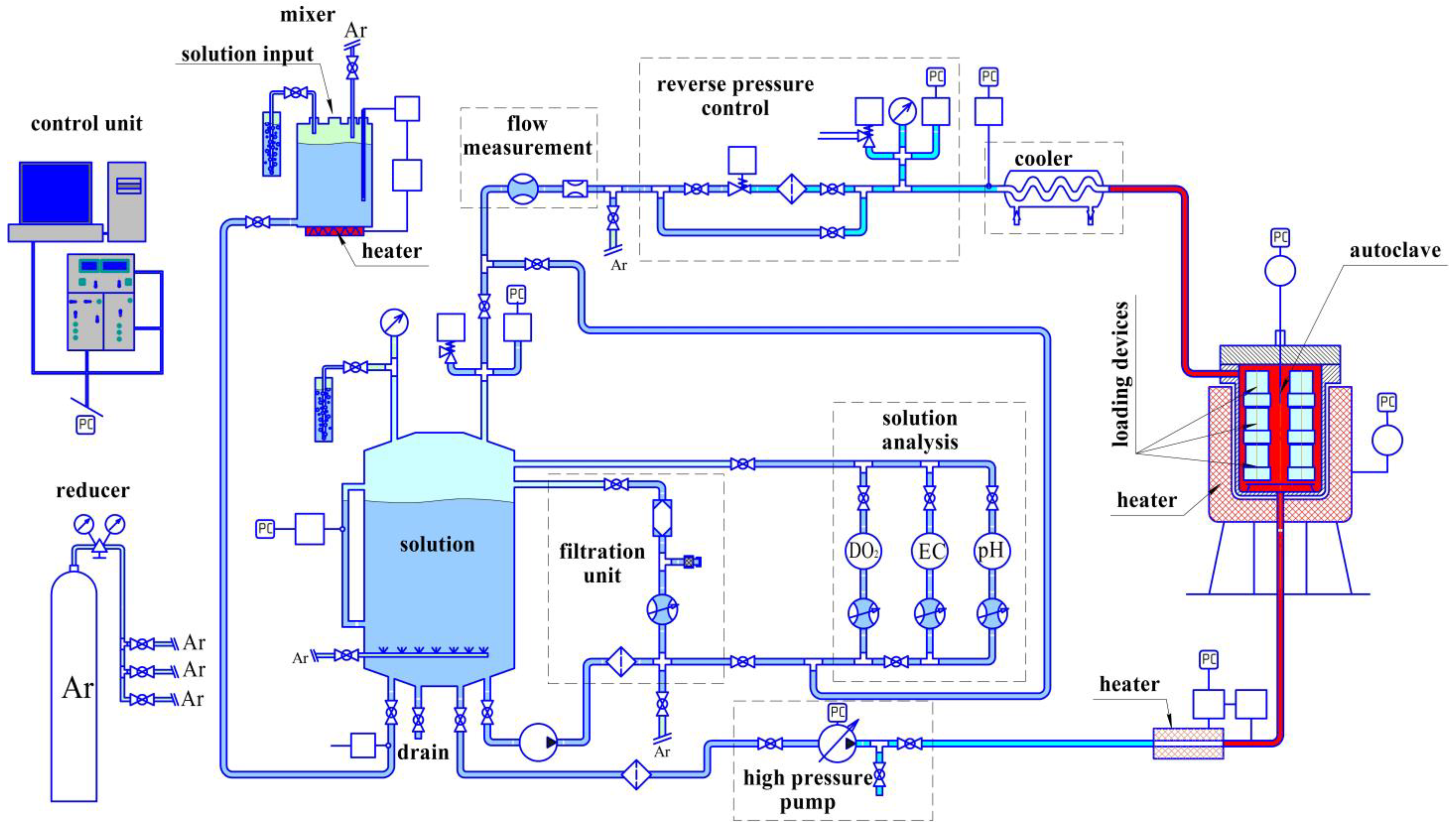




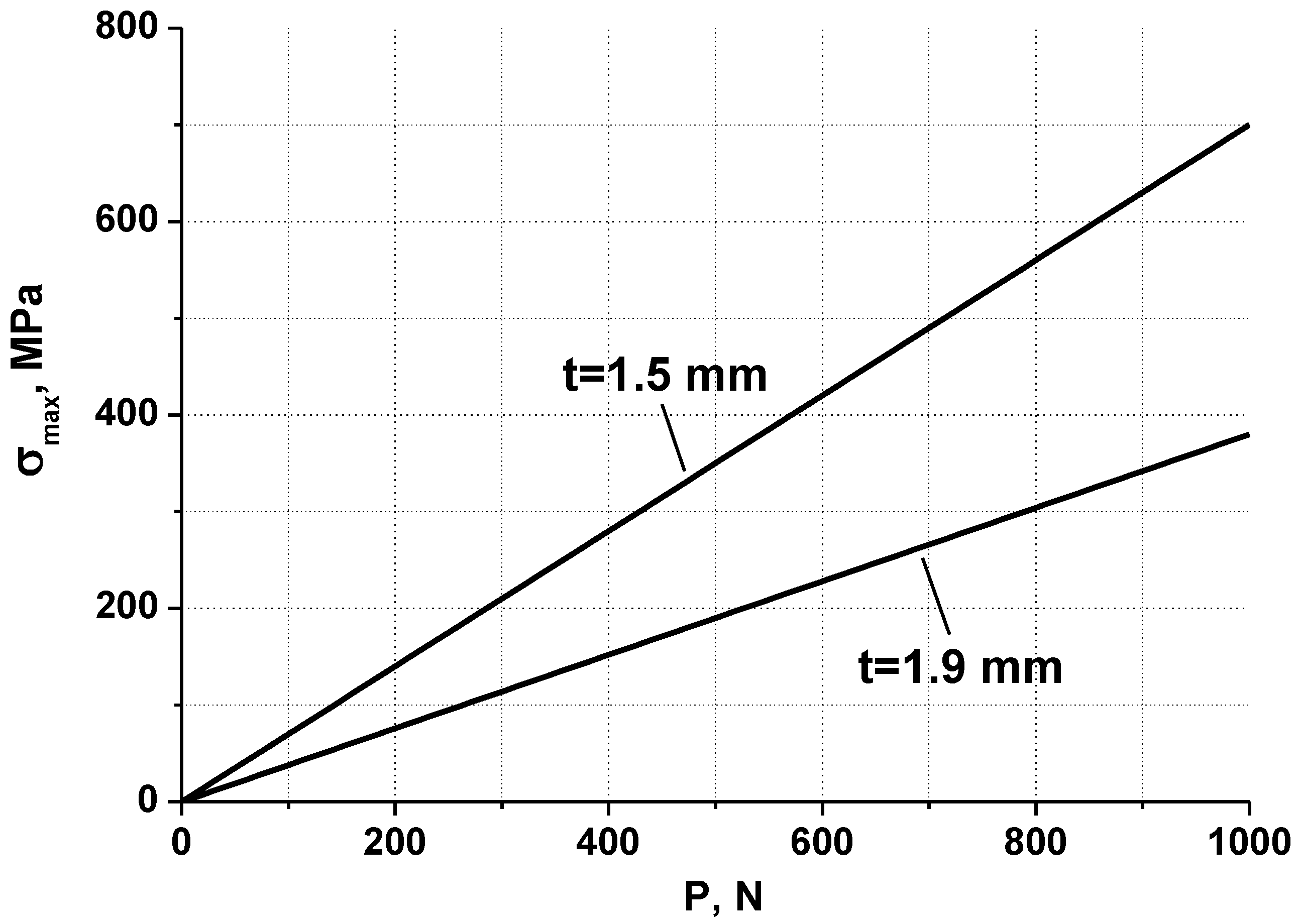
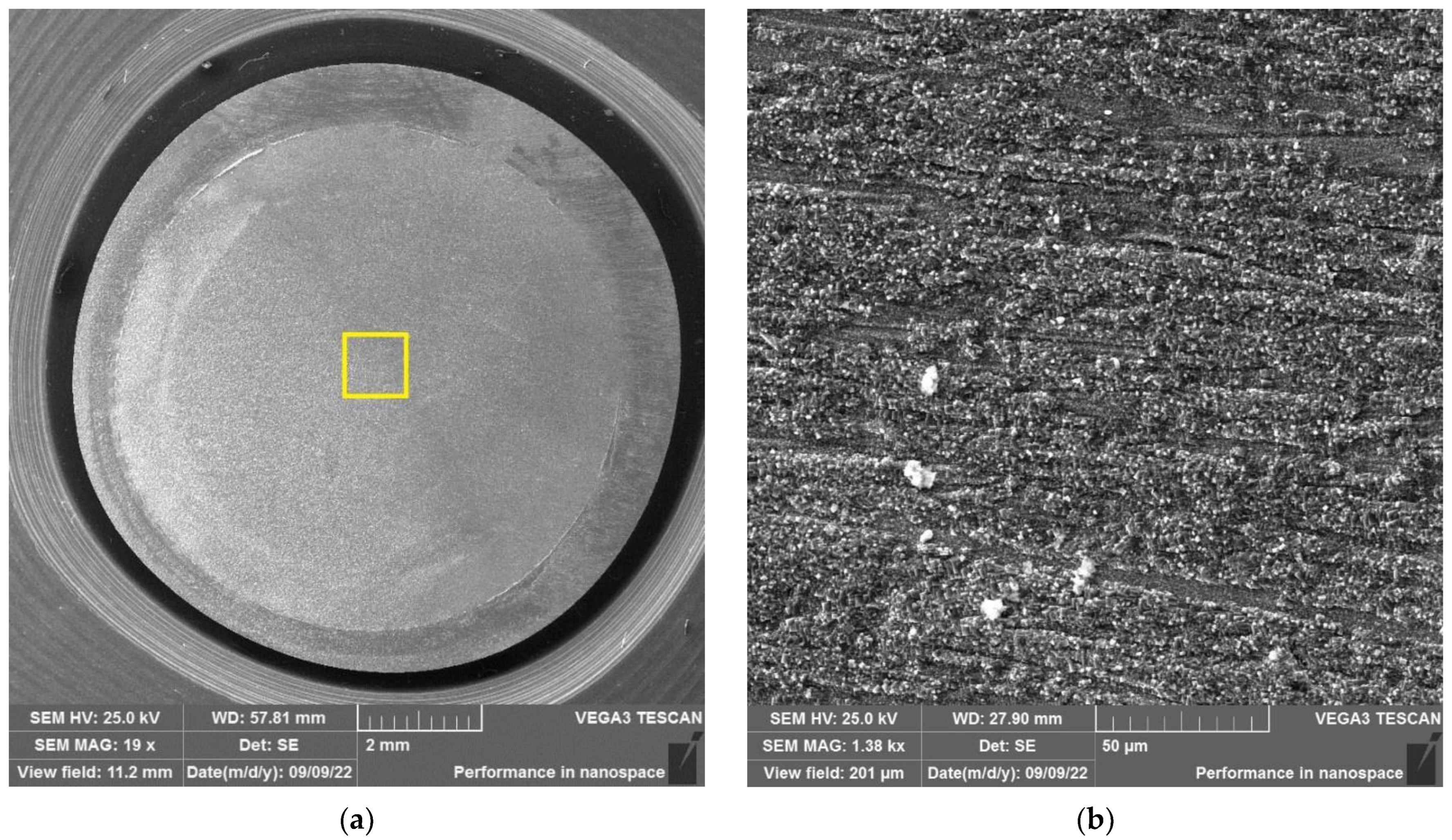

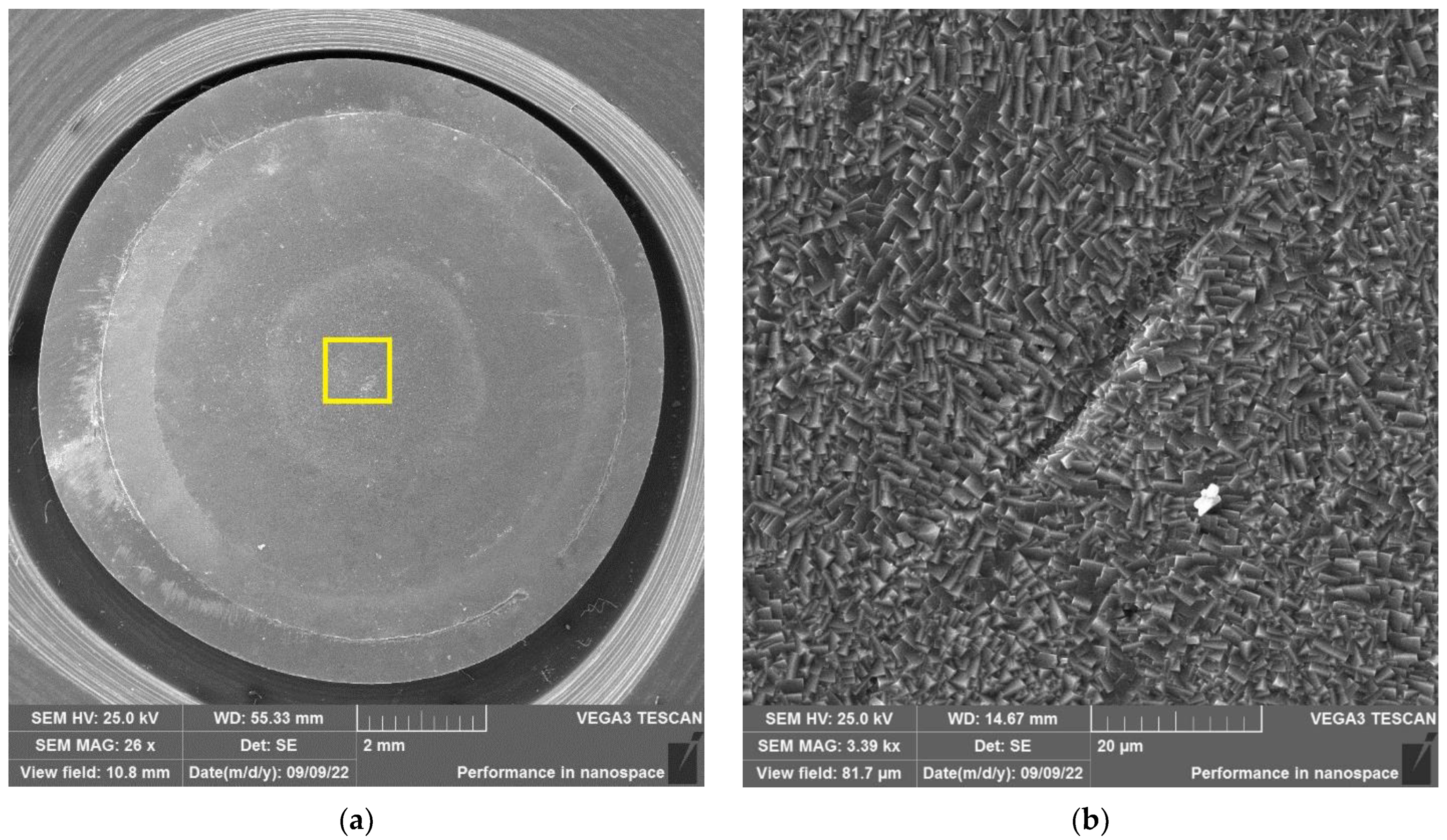





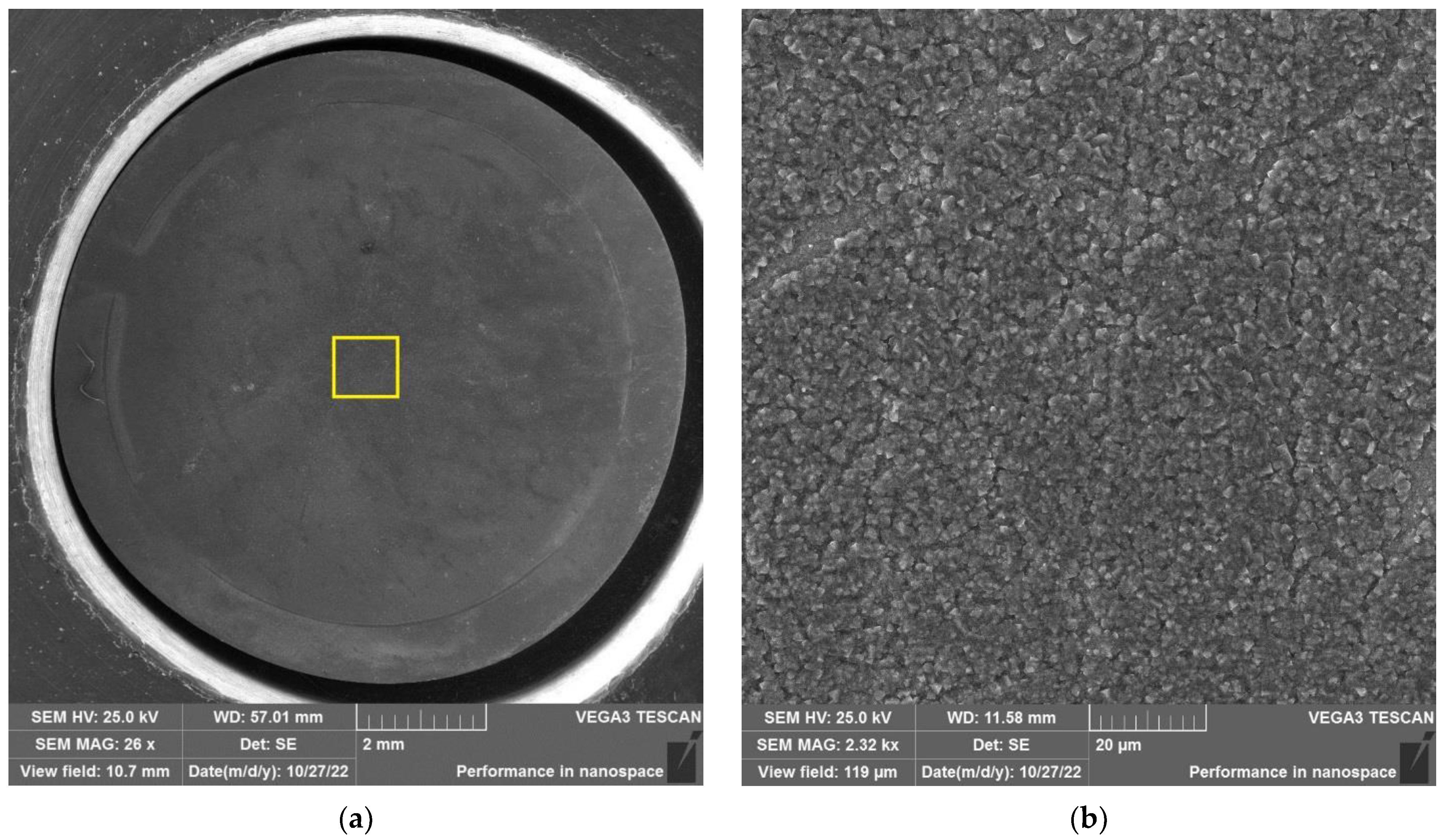


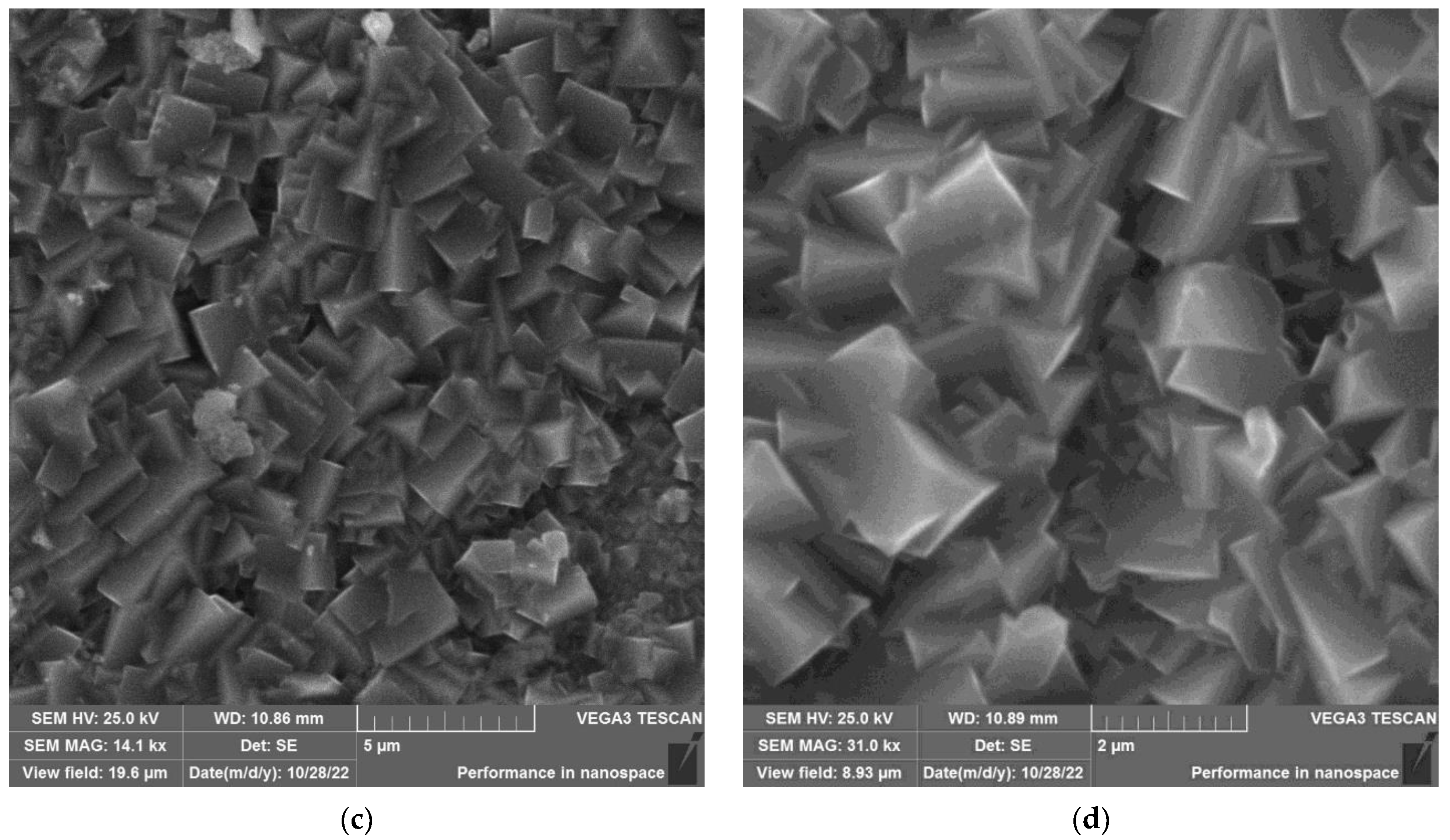
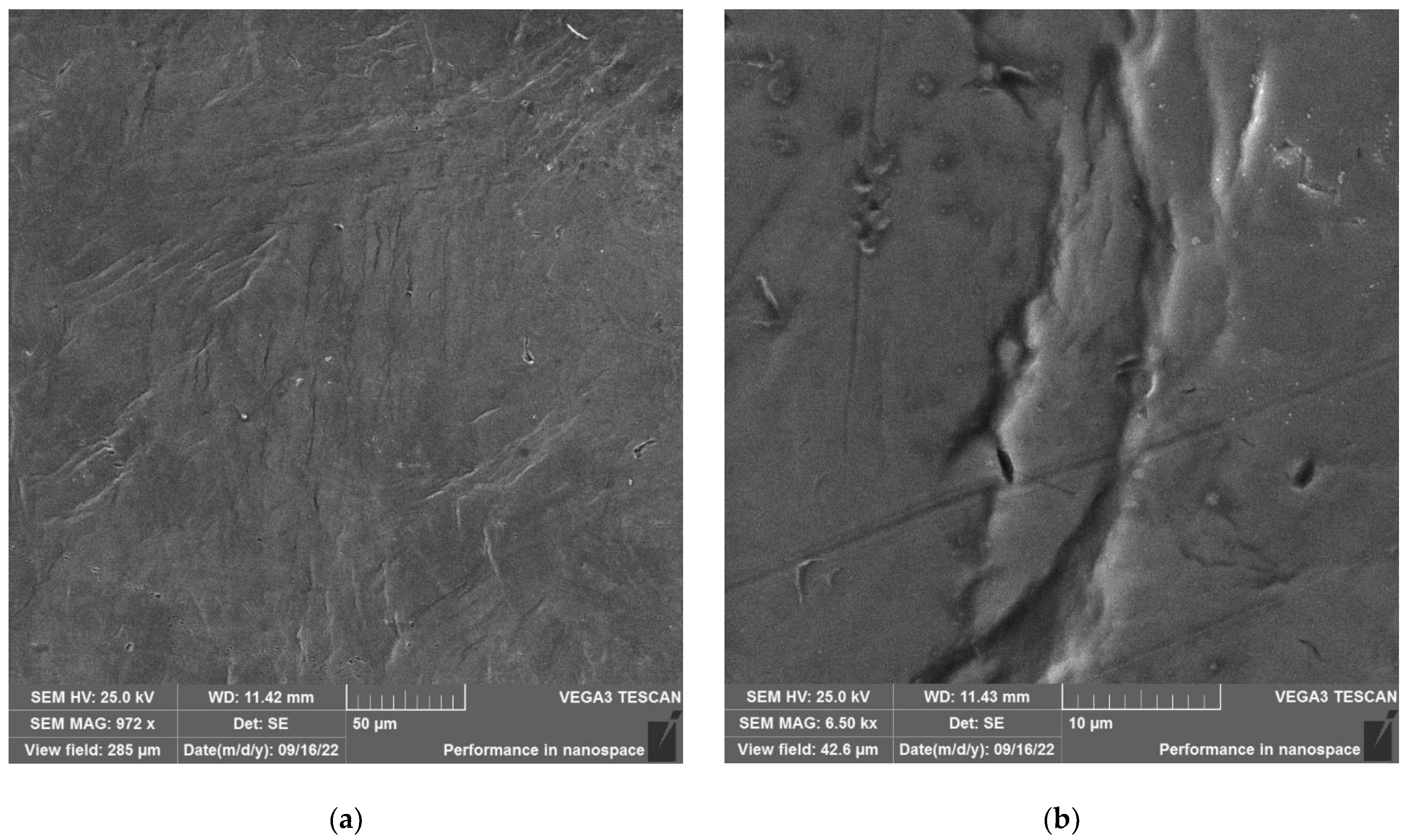

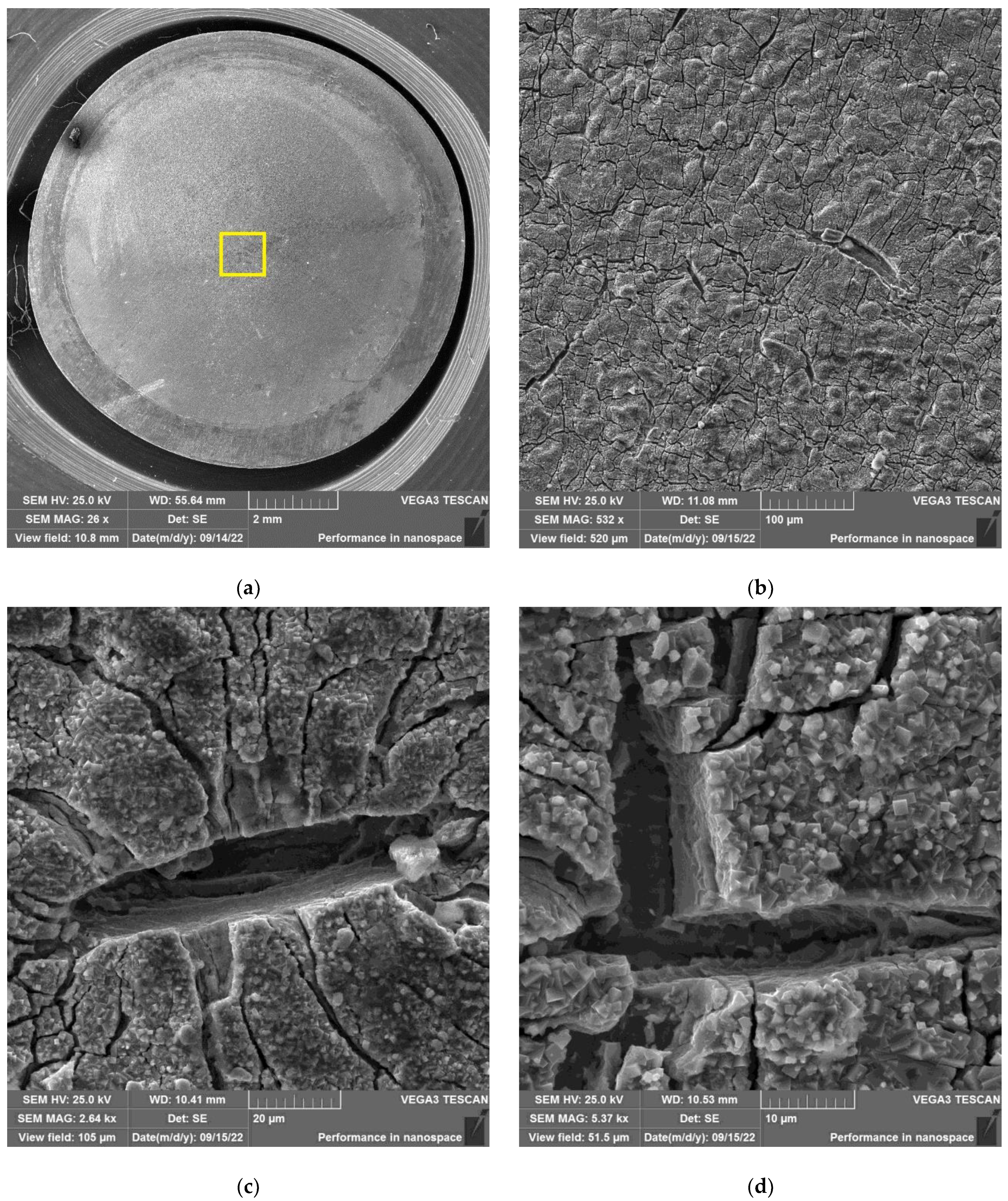

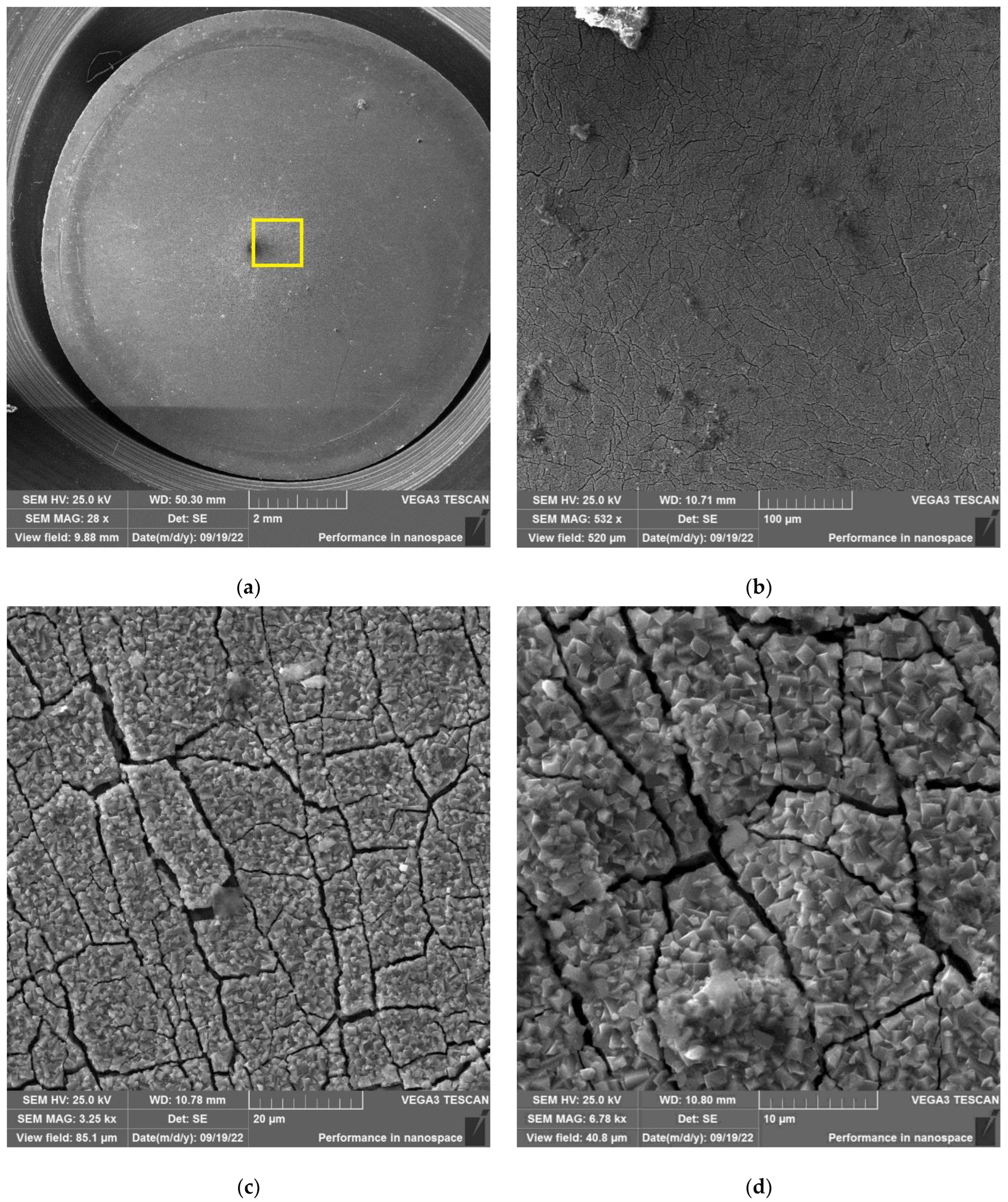
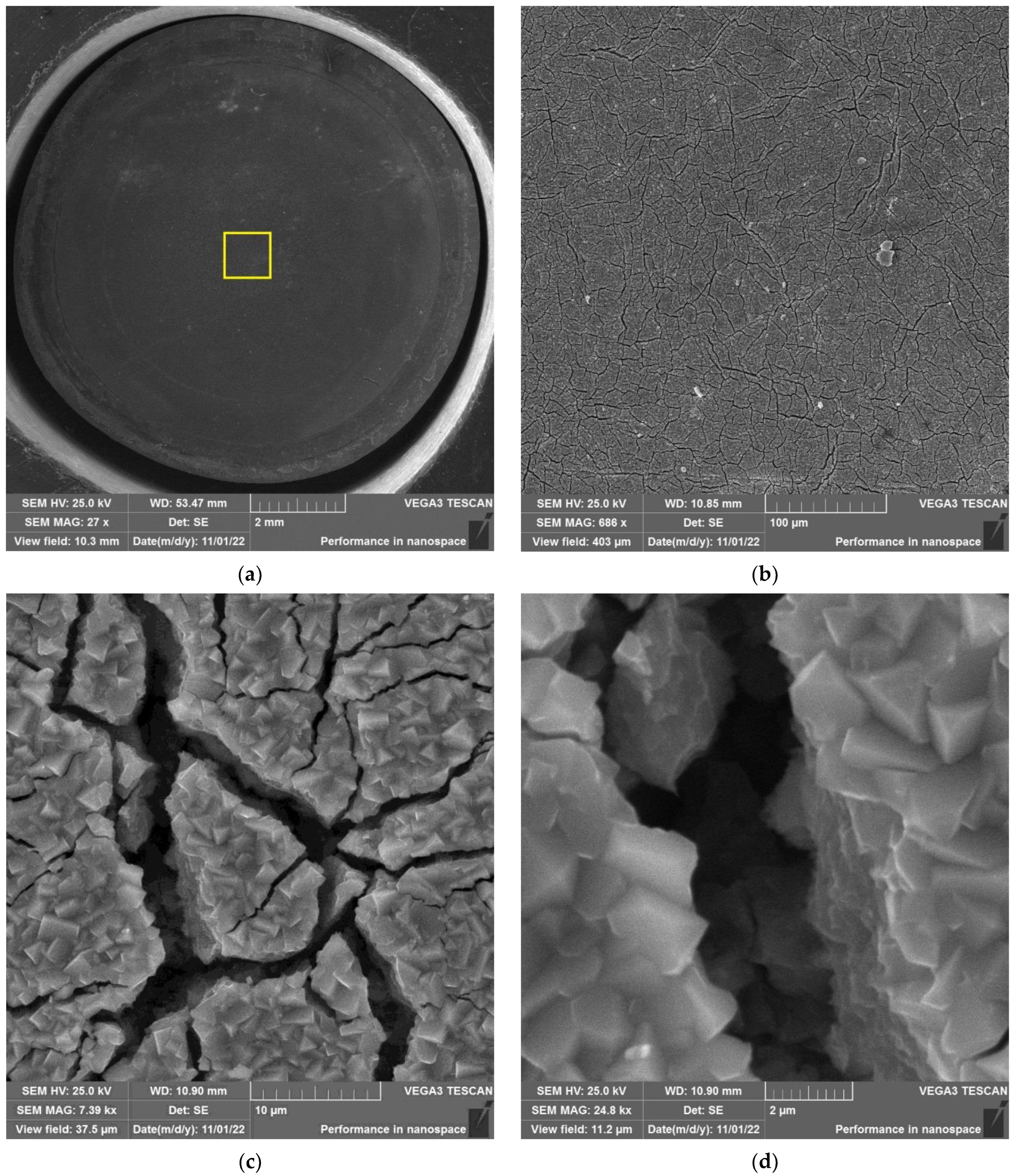
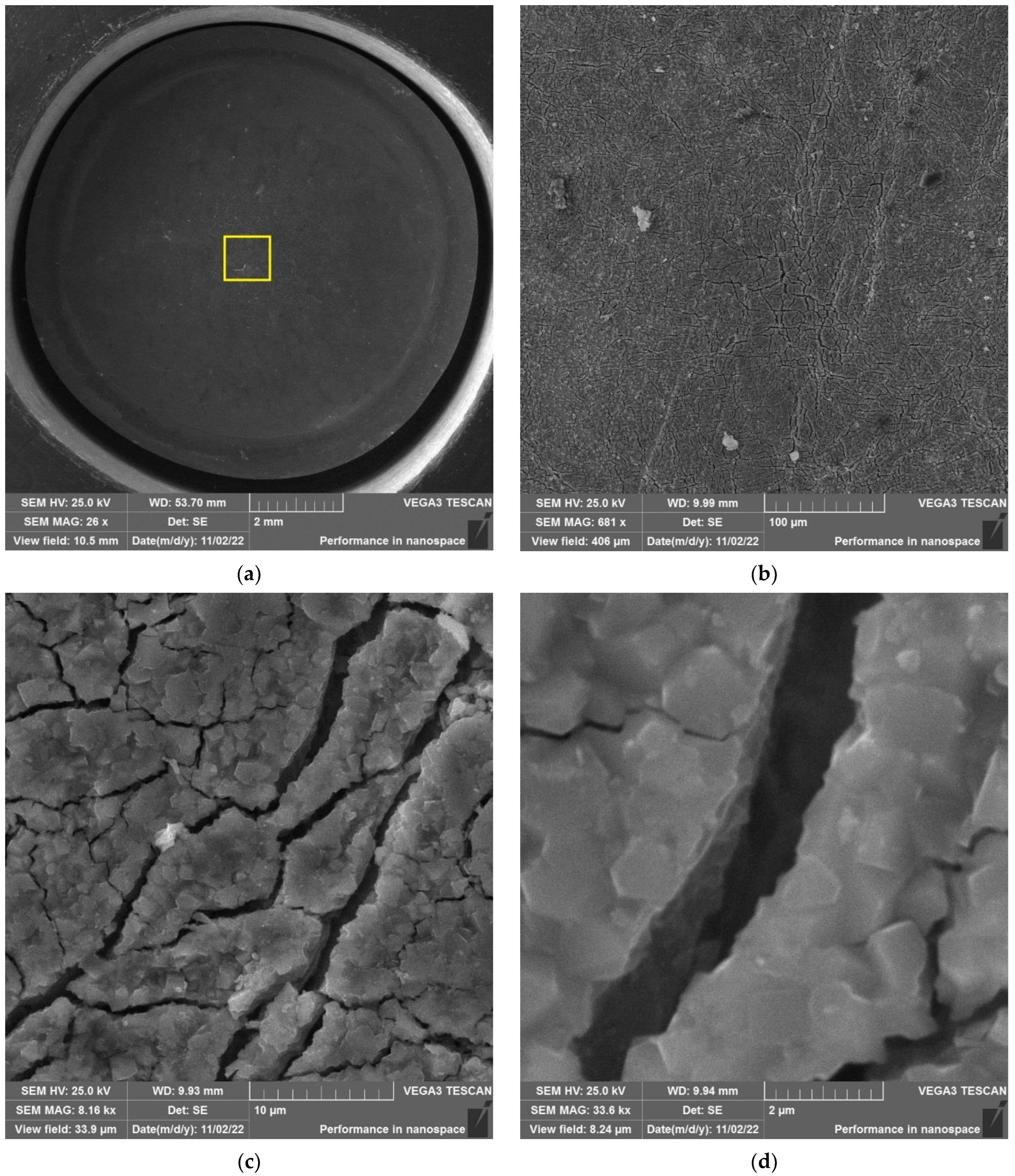
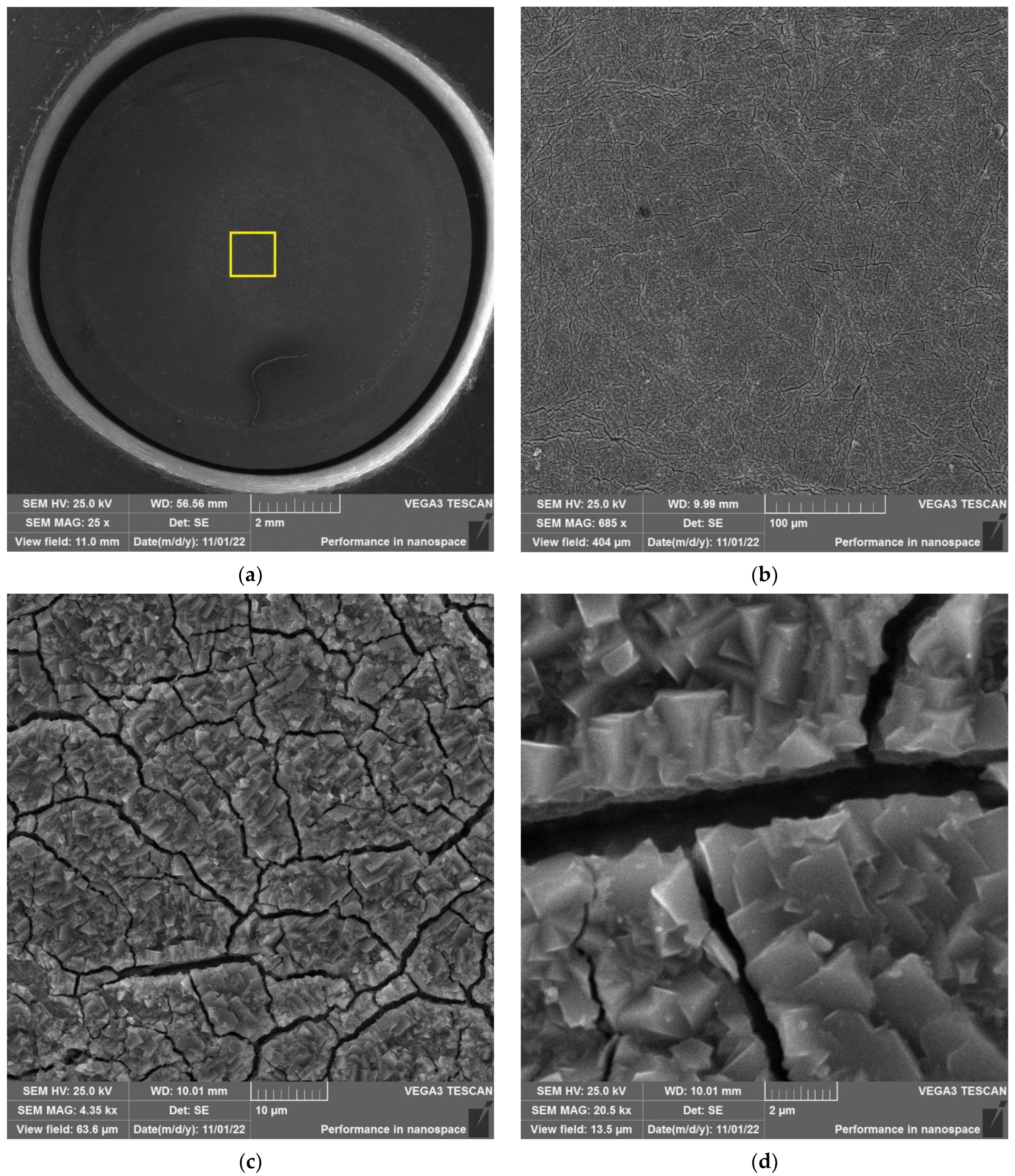
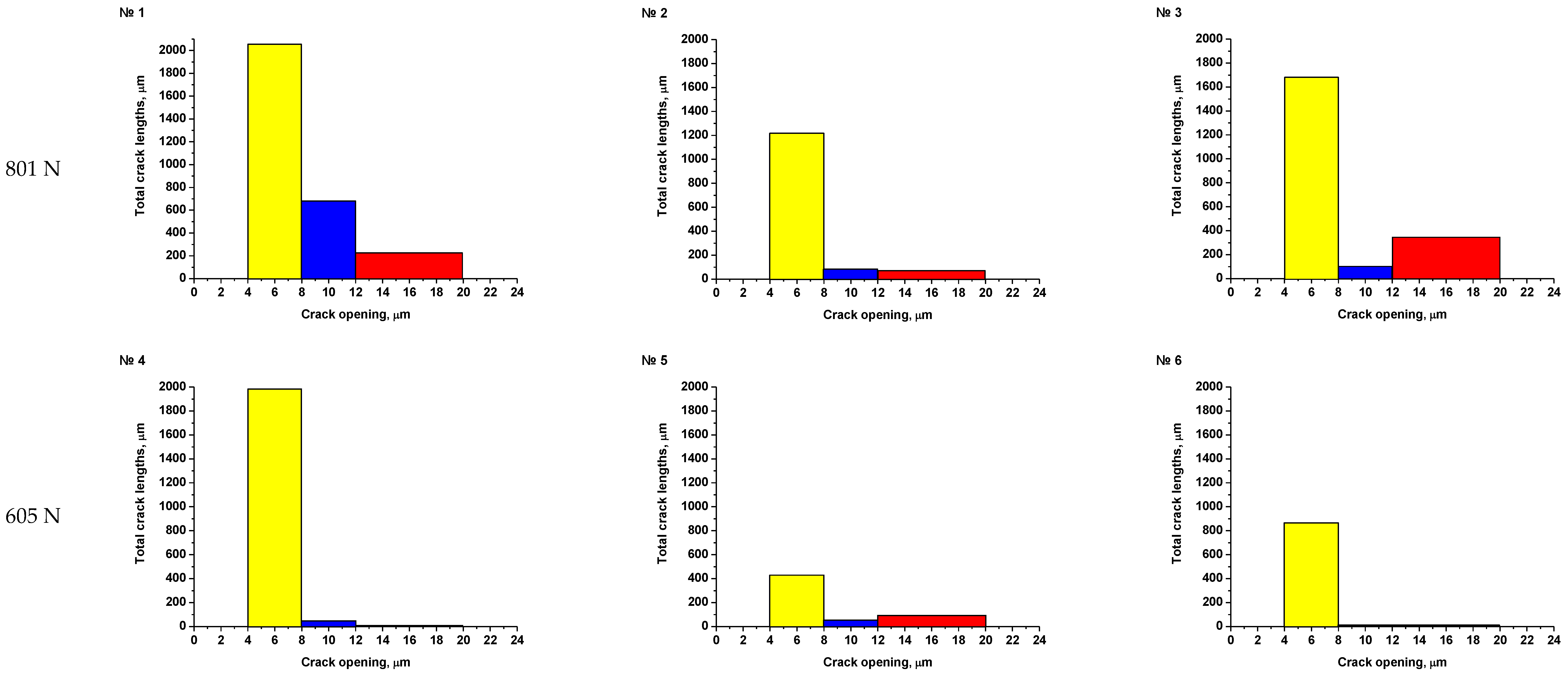


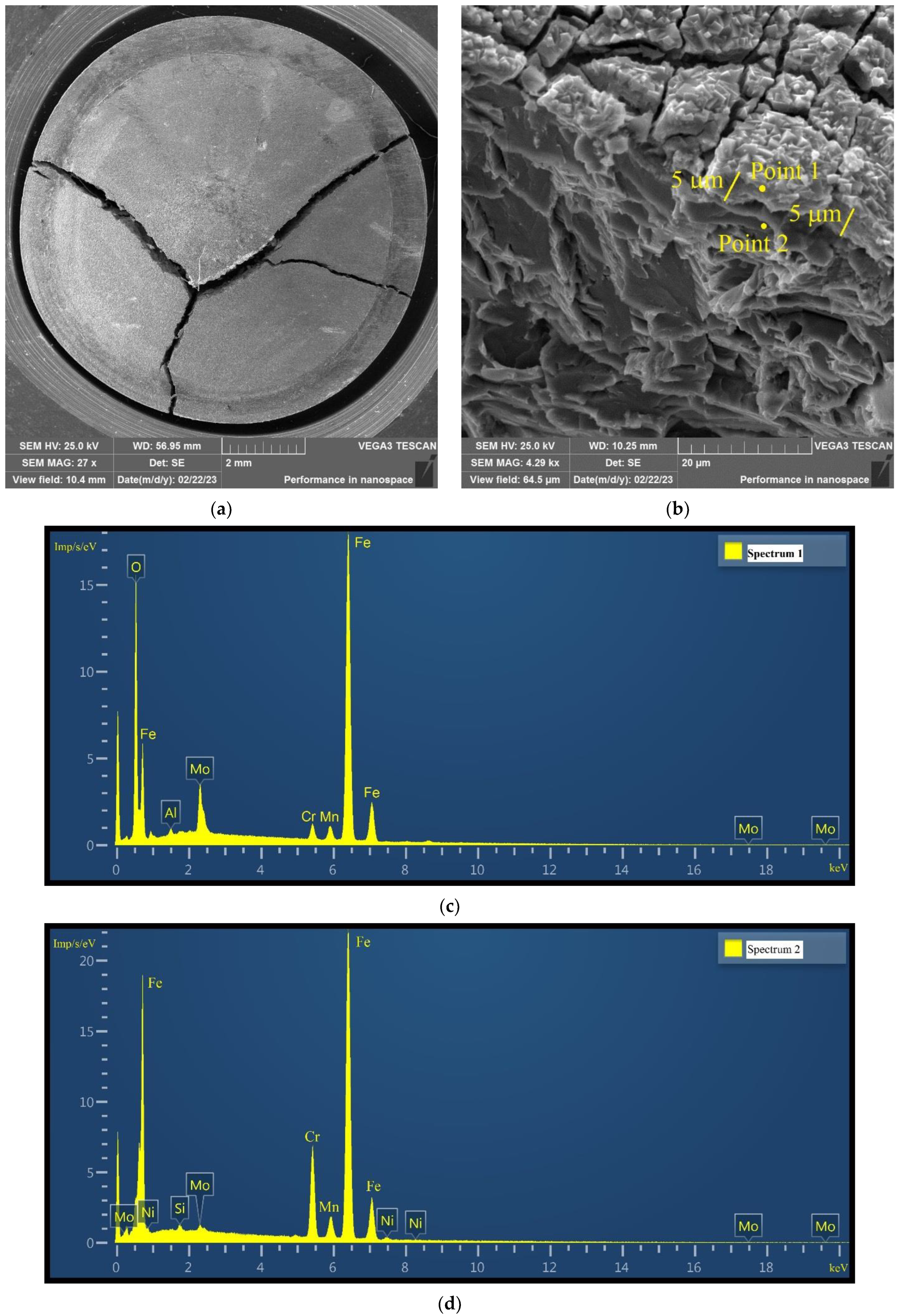
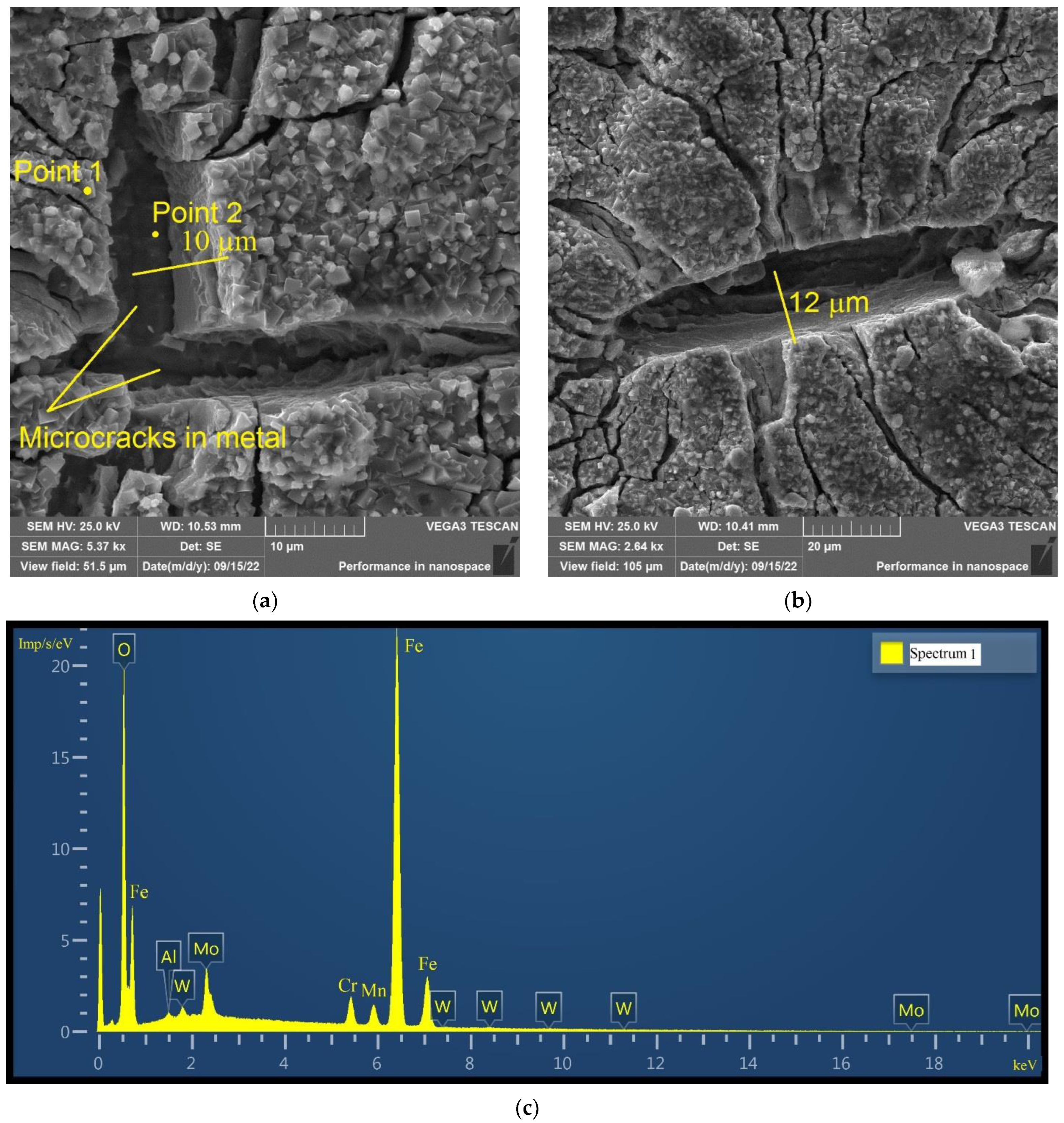

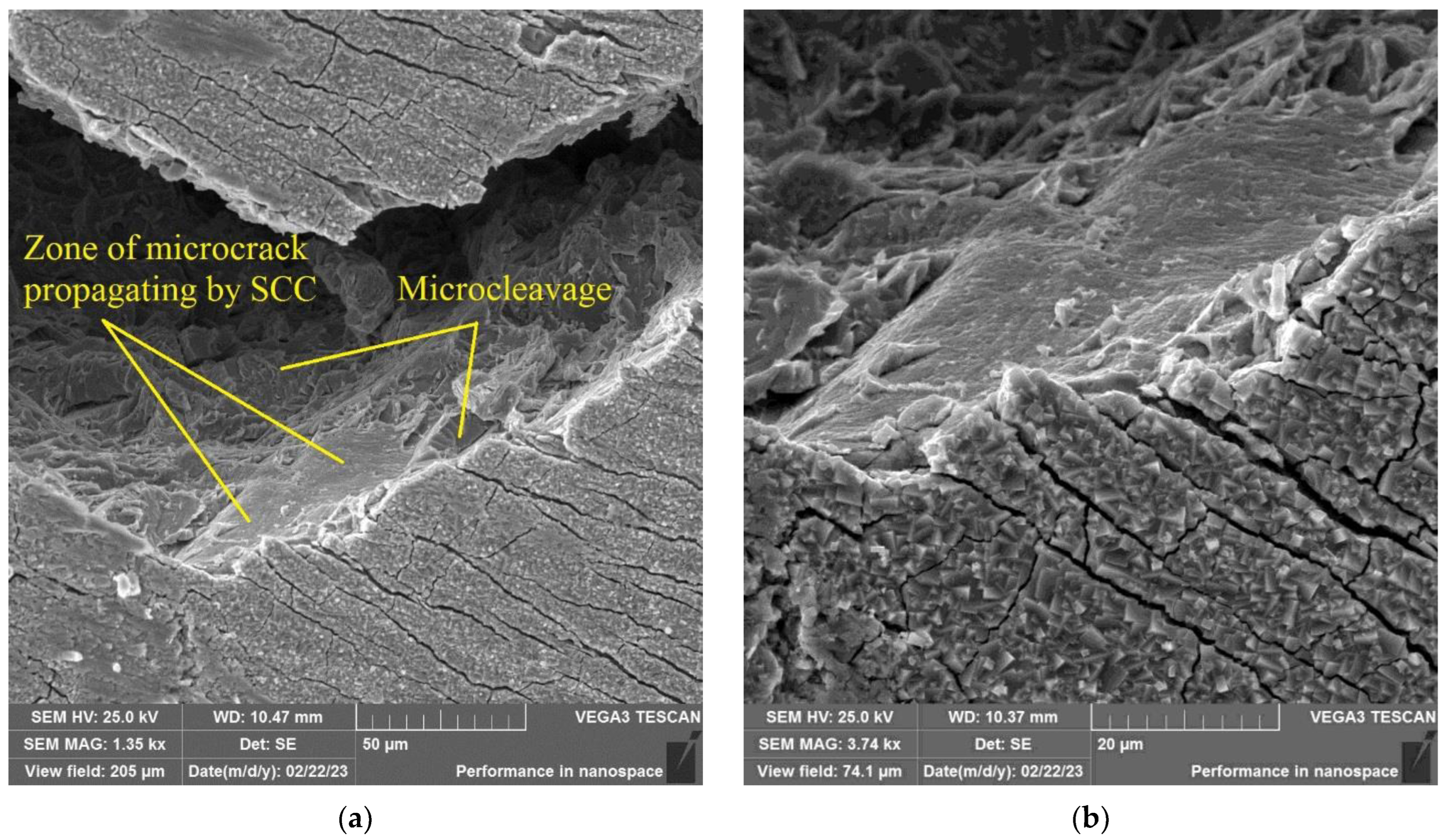
| C | Si | Mn | Cr | Ni | Mo | Nb | V | N | Al | B | S | P |
|---|---|---|---|---|---|---|---|---|---|---|---|---|
| 0.08 | 0.29 | 0.70 | 12.10 | 1.06 | 0.94 | 0.11 | 0.20 | 0.059 | 0.029 | 0.003 | 0.003 | 0.013 |
| Material | Damage Dose, dpa | Irradiation Temperature, °C | Round Bar Dimensions, mm |
|---|---|---|---|
| 12Cr F/M steel | 11.4 | 390 | Ø10 × 57 |
| 12.9 | 550 | Ø10 × 57 |
| Material | t, mm | kp, MPa/N |
|---|---|---|
| 12Cr F/M Tirr = 390 °C | 1.5 | 0.70 |
| 12Cr F/M Tirr = 550 °C | 1.9 | 0.38 |
| Material | t, mm | № | P20, N | Paut, N | σmax, MPa | σY (T = 450 °C), MPa | σmax/σY |
|---|---|---|---|---|---|---|---|
| 12Cr F/M steel Tirr = 390 °C | 1.5 | 1 | 900 | 801 | 561 | 870 | 0.64 |
| 2 | 900 | 801 | 561 | 0.64 | |||
| 3 | 900 | 801 | 561 | 0.64 | |||
| 4 | 680 | 605 | 424 | 0.48 | |||
| 5 | 680 | 605 | 424 | 0.48 | |||
| 6 | 680 | 605 | 424 | 0.48 | |||
| 7 | 475 | 423 | 296 | 0.34 | |||
| 8 | 475 | 423 | 296 | 0.34 | |||
| 12Cr F/M steel Tirr = 550 °C | 1.9 | 9 | 900 | 801 | 304 | 440 | 0.69 |
| 10 | 730 | 650 | 247 | 0.56 | |||
| 11 | 400 | 356 | 135 | 0.31 |
| Material | Ttest, °C | ψ | nε | ||
|---|---|---|---|---|---|
| 12Cr F/M steel Tirr = 390 °C | 20 | 0.45 | 0.59 | 0.36 | 2.00 |
| 12Cr F/M steel Tirr = 550 °C | 20 | 0.52 | 0.73 | 0.45 | 2.50 |
| Material | t, mm | σY, MPa | A, MPa | n | E, MPa | ν |
|---|---|---|---|---|---|---|
| 12Cr F/M, Tirr = 390 °C | 1.5 | 1073 | 244 | 0.36 | 2.0∙105 | 0.3 |
| 12Cr F/M Tirr = 550 °C | 1.9 | 597 | 472 | 0.33 | 2.0∙105 | 0.3 |
| Material | t, mm | Ttest, °C | σY, MPa | P, Providing N |
|---|---|---|---|---|
| 12Cr F/M steel Tirr = 390 °C | 1.5 | 20 | 1073 | 6023 |
| 12Cr F/M steel Tirr = 550 °C | 1.9 | 20 | 597 | 6102 |
| Temperature and Damage Dose | |||
|---|---|---|---|
| = 390 °C, D = 10.3 dpa | 3650 | 2370 | 1280 |
| = 390 °C, D = 11.6 dpa | 3780 | 2370 | 1410 |
| = 550 °C, D = 14.6 dpa | 2380 | 2370 | 10 |
Disclaimer/Publisher’s Note: The statements, opinions and data contained in all publications are solely those of the individual author(s) and contributor(s) and not of MDPI and/or the editor(s). MDPI and/or the editor(s) disclaim responsibility for any injury to people or property resulting from any ideas, methods, instructions or products referred to in the content. |
© 2023 by the authors. Licensee MDPI, Basel, Switzerland. This article is an open access article distributed under the terms and conditions of the Creative Commons Attribution (CC BY) license (https://creativecommons.org/licenses/by/4.0/).
Share and Cite
Margolin, B.; Pirogova, N.; Sorokin, A.; Kokhonov, V.; Dub, A.; Safonov, I. Investigation of Stress Corrosion Cracking Resistance of Irradiated 12Cr Ferritic-Martensitic Stainless Steel in Supercritical Water Environment. Materials 2023, 16, 2585. https://doi.org/10.3390/ma16072585
Margolin B, Pirogova N, Sorokin A, Kokhonov V, Dub A, Safonov I. Investigation of Stress Corrosion Cracking Resistance of Irradiated 12Cr Ferritic-Martensitic Stainless Steel in Supercritical Water Environment. Materials. 2023; 16(7):2585. https://doi.org/10.3390/ma16072585
Chicago/Turabian StyleMargolin, Boris, Natalia Pirogova, Alexander Sorokin, Vasiliy Kokhonov, Alexey Dub, and Ivan Safonov. 2023. "Investigation of Stress Corrosion Cracking Resistance of Irradiated 12Cr Ferritic-Martensitic Stainless Steel in Supercritical Water Environment" Materials 16, no. 7: 2585. https://doi.org/10.3390/ma16072585
APA StyleMargolin, B., Pirogova, N., Sorokin, A., Kokhonov, V., Dub, A., & Safonov, I. (2023). Investigation of Stress Corrosion Cracking Resistance of Irradiated 12Cr Ferritic-Martensitic Stainless Steel in Supercritical Water Environment. Materials, 16(7), 2585. https://doi.org/10.3390/ma16072585






